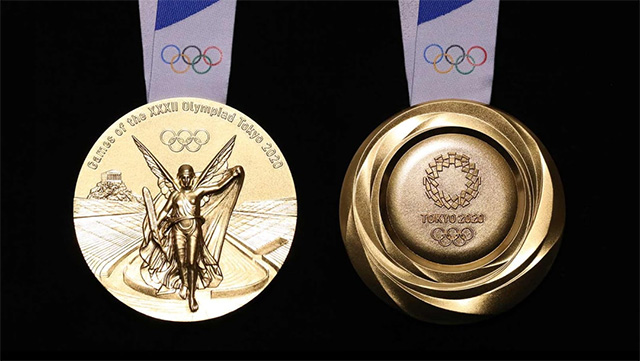Hidilyn Diaz ended the Philippines' nearly century-long wait for an Olympic gold medal and at the end of her record-setting weighlifting match in Tokyo, she clutched it in her hands (nail art and all, as shown in official photos) for an adoring nation to see.
Also read: Two Filipina Athletes Take on the World Stage and the Result Is Meme-Worthy
The gold medal for the Tokyo games is actually made of silver, plated in no more than six grams of gold, hence the color. The Japanese are that precise. It weighs 556 grams, heavier than silver (550 grams) and bronze (450 grams), according to the official games website.
All three medals have a diameter of 85 millimeters, with a thickness of 7.7 mm at the thinnest part and 12.1 mm at the thickest. Pursuant to specifications of the International Olympic Committee, the obverse side of the medal should bear the image of Nike, the Greek goddess of victory, in front of the Panathinaikos Stadium, the Olympic five rings symbol and the official name of the games, in this case—Games of the XXXII Olympiad Tokyo 2020.

The Tokyo 2020 medal design was selected from 400 entries across Japan, with the winning design coming from Junichi Kawanishi, director of both the Japan Sign Design Association and the Osaka Design Society.
The red, white and blue colors on the medal ribbon are a nod to Japanese design motifs: ichimatsu moyo (harmonised chequered patterns) and kasane no irome (traditional kimono layering techniques) in a modern presentation.
Silicone convex lines on the surface of the ribbon help distinguish the type of medal (gold, silver, bronze) simply by touching it, according to the games website.
The theme of the medal ribbon is "Unity in Diversity," which is timely for conservative Japan. That was also reflected in the opening ceremonies where former world number one tennis player Naomi Osaka lit the Olympic flame in dreadlocks and street wear.
Conservative Japan has struggled to accept bi-racials, called hafu, like Osaka, whose mother is Japanese with a Haitian-American father.

When Diaz competed for the gold, she wore the Miraculous Medal of Our Lady, as pointed out by The Manila Cathedral, the Philippines' Mother Church.
Diaz said she and her family prayed a nine-day novena for her win. Explaining the symbolism of the medal, she told reporters: "It's a sign of 'yung prayers nila and faith pa rin, to Mama Mary and Jesus Christ."
[facebook:https://ift.tt/3x9y7sP]
Source: Spot PH
No comments:
Post a Comment